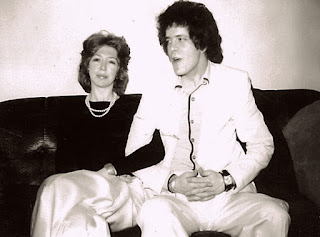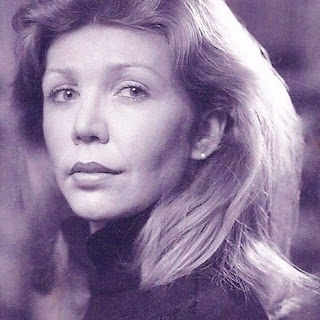Sunday, October 31, 2021
Rock Wives: Bettye Kronstad, Angie Bowie, Lynn Krieger, Pam Courson (Set the Night on Fire)
Monday, October 25, 2021
The Velvet Underground (2021) by Todd Haynes
In the new Apple documentary "The Velvet Underground" (2021), Lou Reed says he made $2.35 royalties for his pre-Velvet song "Leave Her For Me", more than he made with the Velvets. But The Velvet Underground is, along with the Beatles and the Rolling Stones, one of the three seminal groups in the history of rock ‘n’ roll. If you want to see the Velvets in their prime performing “What Goes On” or “White Light/White Heat” in a steamy rock club, or get a taste of what it was like to see the Exploding Plastic Inevitable at the Dom in New York City in 1966, you’re out of luck, because those clips basically don’t exist. It’s quite an irony considering that Warhol, the band’s mentor, was notorious for filming everything around him. The Velvet Underground, whose music was a mesmerizing midnight trance-out, had no radio niche, no publicity, no “media,” no backstage verité Pennebaker or Maysles. Todd Haynes appears to have vacuumed up every last photograph and raw scrap of home-movie and archival footage of the band that exists and stitched it all into a coruscating document that feels like a time-machine kaleidoscope that immerses you in the band but still leaves them slightly out of reach. The film interviews Reed’s sister, Merrill Reed Weiner, who sets us straight on the legendary tale of how the teenage Lou’s suburban Long Island parents okayed his getting electroshock therapy because they wanted to shock the homosexuality out of him. (She says that’s untrue.)
Thursday, September 30, 2021
Bombshell, The Last Days of Marilyn Monroe
Tuesday, September 28, 2021
Heroes and soulmates: John Kennedy Jr & Carolyn Bessette, Jim Morrison & Pam Courson
Saturday, September 25, 2021
The Camera is the Rifle: Oliver Stone (JFK Revisited), John Newman's Into the Storm
The Camera is the Rifle: an Interview With Oliver Stone by Dennis Bernstein for Conterpunch.org
Bernstein: You have had some pretty strong critiques of your work. You’ve been successful, but a lot of people get very angry; for instance around JFK. Is it because the truth hurts?
Stone: Oh, I guess it does. They don’t want to admit it. You’re asking me an obvious question. Why would they get angry? There’s a long list of people who’d like to see me, among others, see me dead.
DB: Right. And when you raised the issue about JFK; I mean you did the film, and I understand you’re still working on the story of JFK.
OS: The story never went away, because it was never solved. We just made a documentary called JFK Revisited. It’s going to be released in November of this year in the United States. We showed it at Cannes very successfully; we sold 10-12 countries and it’s coming out here in November. So the case has never ended; they never solved it. The investigations kept coming. Our film created a third investigation called The Assassination Records Review Board, and they interviewed a lot of people who were still alive back in ’94 and ’98. And they wrote up these things that were said and done, and a lot of people had provisionist stories to tell. And of course it was ignored for the most part. It was really ignored by the media. Americans love to say well, we’re going to make an investigation, another investigation. But then they never follow up because it’s tedious over four years to follow all the little details. Well we did. The people in this JFK research community did follow it, and there’s a lot there. There were – 60,000 documents were declassified, and almost two million pages. On the other hand, Trump backed down at the last second and he was swamped with CIA objections; and he put a lid on it and he changed the law. He basically did it illegally; not with the authorization of Congress. And now the law is – they’re not respecting the law. We still have these 20,000 documents that are still classified. And there’s a lot there. There may not be, but you have to get into the CIA people. The CIA has been most obstructive to the investigation. They don’t release the files on some of these key agents that appear around the edges of the story, like David Atlee Phillips, George Joannides in Miami, or William Harvey who was around the Cuba operation. There’s a lot there, but who knows what’s in there? But the point is we accepted the Warren Commission, which was a joke. We go back in the film and show the basic evidence: the bullet, the rifle, the fingerprints, everything that matters in a murder trial. And we show it to be completely phony. There’s not one piece of evidence that really holds up against the so-called Oswald killer routine. It’s disgusting.
DB: What do you think? You’ve spent so much time; what are some of the basics that people should know, that should be taught in the history books; in the alternative history books?
OS: I’ve written about it, and the documentary is made. I don’t think there’s time to go into it all. It’s about Oswald, it’s about the evidence, it’s about the Warren Commission itself and how crooked it was. All this has come out in declassifications. We have to cover a lot of bases, and there’s no one headline. Also, the big question is why, why, why was Kennedy killed? I keep re-emphasizing that. And I can tell you that our history books are still screwed up. I mean if you were to believe them, Mr. Johnson, Lyndon Johnson, succeeded Kennedy smoothly and continued his policies in Vietnam. This is rubbish; complete rubbish. We have proof now through declassification that Kennedy was absolutely withdrawing from Vietnam, win or lose. And they said that’s what he told McNamara; McNamara said it in his book. He was Secretary of Defense. McGeorge Bundy, who was pro-Vietnam war, also says it very clearly in his book. These things are written years after. People don’t pay attention. The historians still go on with that nonsense about Lyndon Johnson was a successor. But he changed everything in the foreign policy of Kennedy. Everything from Vietnam to Cuba to – Kennedy was working on another détente with the Soviet Union and Johnson never did anything towards détente. He moved the other direction, encouraged dictatorships and overthrew a government in Brazil, and all over the world, in Greece in 1967. You see a complete repudiation of the Kennedy doctrine. Kennedy had the Alliance for Progress in South America; out the window with Johnson. In Africa, Kennedy was making huge strides to make allies with a whole new generation of Africans; all out the window. In Asia of course, Kennedy was working with Indonesia; he liked Sukarno. With Johnson they get rid of Sukarno and there’s the bloodiest coup d’états of all time; a million people are killed because they were so-called Communists. But those are lists of course put together by the American CIA, and it’s just murder. That’s what it was, just outright murder. The world has gotten very violent and ugly, and we’ve played a huge role in bringing that about.
DB: All right, sure. Well, I want to thank you for joining us. Can I just ask you, are there any more feature films coming up? Is there – are you in a different place now?
OS: Yeah, I’m in a different place. I’ve made a nuclear energy documentary, which is very, very fact-based and I think will be very interesting and possibly move some marbles around here. Because we need to get going and get clean energy. We’ve got to get the CO2 out of the fucking system; out of the system. And it’s going to take a lot of work. People are dreaming when they think about if windmills and sun are going to do the whole job, they’re not. Certainly they’re good, but they need a lot of help. And we’re not going to make it unless we use nuclear energy, and a lot of it. A lot of it. So there has to be a change in thinking. But it’s not just us; it’s the whole world that we have to change. The whole world. Source: www.counterpunch.org





















































